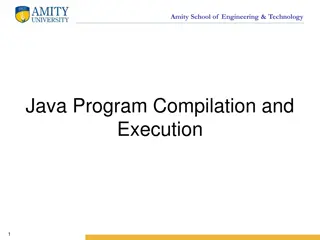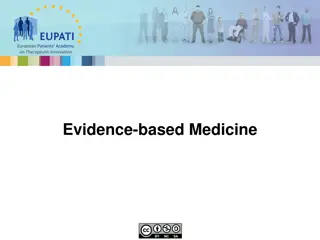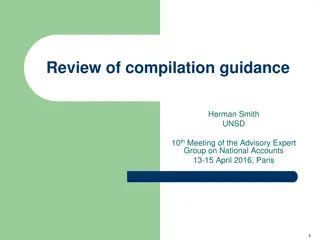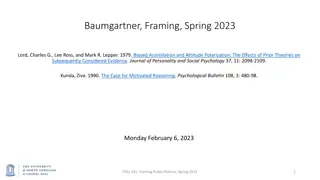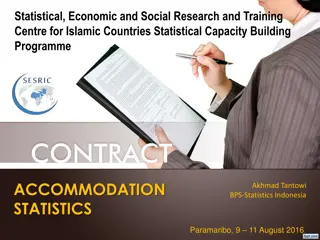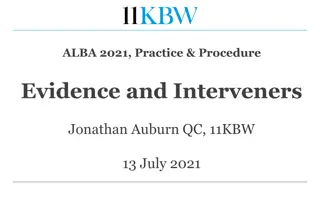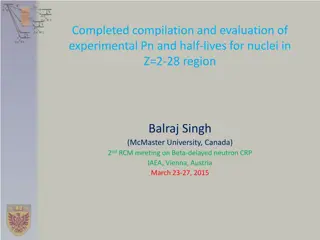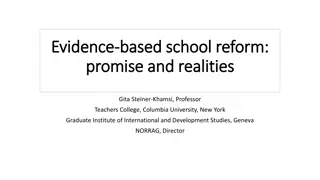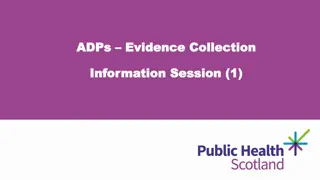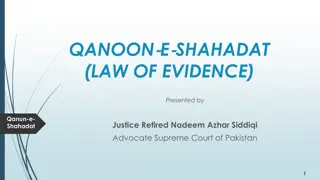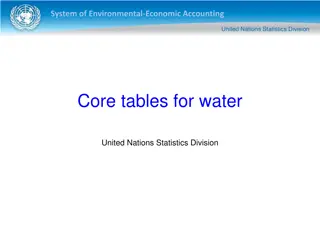Developing Policies Based on Evidence Data Compilation
Presentation plan for policy development based on evidence from systematic surveys and reliable data compilation methods. Objectives include identifying labor market trends, compiling data for planning active labor market policies, and reaching targets for job placements and vocational training. The importance of utilizing complete and true data for making the right decisions is emphasized.
Download Presentation

Please find below an Image/Link to download the presentation.
The content on the website is provided AS IS for your information and personal use only. It may not be sold, licensed, or shared on other websites without obtaining consent from the author.If you encounter any issues during the download, it is possible that the publisher has removed the file from their server.
You are allowed to download the files provided on this website for personal or commercial use, subject to the condition that they are used lawfully. All files are the property of their respective owners.
The content on the website is provided AS IS for your information and personal use only. It may not be sold, licensed, or shared on other websites without obtaining consent from the author.
E N D
Presentation Transcript
Presentation Plan Developing Policies Based on Evidence Data Compilation Methods of ISKUR Labour Market Surveys 27.02.2025
Policy Development Based on Evidence Developing policies based on results of a careful and meticulous survey by using reliable and transparent data Policy development based on personal judgements and thoughts
Complete and True Data Right Decision Data accesed on time
Ways of Reaching Evidence Systematic Survey One Social Scientific Survey to Be Conducted for Policy Topic Pilot scheme or case study Remarks of Experts
Data Compilation Methods of ISKUR Survey Data Administrative Records
Survey Data Labour Market Survey (LMS) Job Vacancy Statistics Survey
Objectives of Labour Market Survey Identifying trends of short term labour demand in local level Current employment (according to Occupation and Gender) Job Vacancy (Occupation, Education, Gender, Skills, Way of Meeting, Seeking Period) Occupations thatAre Difficult To Provide (Reason) Employment Trends in Future Period (Vocation & Sector) Determining job vacancies on the basis of provinces, sectors and occupation groups
Objectives of Labour Market Survey Compiling data for planning Active Labour Market Policies according to needs; Compiling job vacancies in the market that cannot reach the Agency, Ensuring Labour Force Training Courses are launched according to needs, Reaching targets related to job placements and workplace visits, Directing vocational training applications, Obtaining a basic report including data of labour market supply and demand in local level
2016 LMS - Method Scope: Private sector workplaces with 2-9, 10-19 and 20+ employees throughout Turkey. For workplaces with 20+ employees, Full Enumeration Method in 77 provinces and Sampling Method in 4 provinces For workplaces with 2-19 employees, Sampling Method in 81 provinces In 17 sectors in 21st Division of NACE Rev.2. (except for Agricultural, Public, Household employers and representatives from international organisations) Field application: 8 April 6 May 2016 The study is workplace-based (local unit).
Labour Market Surveys While face-to-face interviews with employers and the style of filling forms through the internet were used as survey methods, workplace information forms began to be filled through only face-to-face interview method as of 2012.
Labour Market Survey The forms which are filled by our personnel are being transferred to General Directorate through data entrance monitor.
PA 2012-2016 132.024 140.000 129.065 120.000 110.509 103.390 100.852 100.000 88.966 87.719 80.000 68.488 65.723 53.194 60.000 40.000 20.000 0 2012 2013 2014 2015 2016 Toplam yeri Cevapl
DUTIES OF THE DEPARTMENT LMS THE DOCUMENTS IN WHICH LMS RESULTS ARE USED 10th Development Plan (2014-2018) Turkish Industry Strategy Paper (2011-2014) Vocational and Technical Training Strategy and Action Plan (2013-2017) Productivity Strategy and Action Plan (2013-2017) Action Plan on Strengthening the Relation between Employment and Vocational Training ( ME GEP) SME Strategy and Action Plan
DUTIES OF THE DEPARTMENT LMS THE RESULTS OF LMS It is used by Ministry of Family and Social Policies Ministry of Culture and Tourism for their studies of (TUYUP Project) Council of Higher Education and Ministry of National Education, for the schools and departments to be opened Our Agency for planning of ALMPs in Decision makers in national and local level
Survey on Job Vacancy Statistics Together with the Second Formal Statistical Programme that covers years 2012-2016, KUR is charged with the task of collecting job vacancy statistics by means of questionnaire 4 times a year. In this scope, job vacancy statistics are compiled in line with EU legislation and job vacancy rate in Turkey is calculated for three-month periods. In the framework of EU legislation, job vacancy data must be classified based on NACE Rev.2 (sector) and sent to EUROSTAT.
Scope of the Survey Scope: As TURKSTAT Job Registration System is to be used as a base, it consists of enterprises/businesses with 10 or more employees in the related sector within the sectorial scope. Geographical Scope: It includes all provinces and countries within the boundaries of Turkish Republic regardless of population. Sectorial Scope: According to NACE Rev 2 classification, it is composed of 17 sectors other than agriculture, forestry and fishery, public administration and defence, compulsory social security, activities of households as employers and activities of International organizations and their offices.
Field Study Period of the Survey Within this framework, the first field study period of the survey that would be conducted in November 2014 was 17-28 November, 2014. Field study periods in 2015: 16-27 February,2015; 18-29 May, 2015; 17-28 May, 2015; 16-30 November, 2015. Field study periods in 2016: 15-29 February, 16-31 May, 15-31 August, 14-30 November. In 2015, 9 thousand 700 workplaces were visited in each quarter whereas 10 thousand 347 workplaces have been visited in 2016.
Administrative Records Basic Indicators Related to Employment Services: Applications Vacancies Job Placements Invitation Registered Labour Force and Unemployed Applications for working abroad and sending workers abroad Quotas for compulsory employment (disabled, ex-convict, TMY) Public Works Basic Indicators Related to Unemployment Insurance Activities Applications for unemployment insurance and those who are entitled to receive Applications for job loss compensation and those who are entitled to receive
Basic Indicators Related toActive Labour Market Services: Vocational training courses and the number of trainees On-the-job training programs and the number of programs and trainees Entrepreneurship training programs and the number of programs and trainees Basic Indicators Related to Job and Vocational CounsellingActivities: Individual and group interviews Counselling activities for schools Occupation surveys Visits to job places
THANK YOU (O uz D ZG N) oguz.duzgun@iskur.gov.tr



